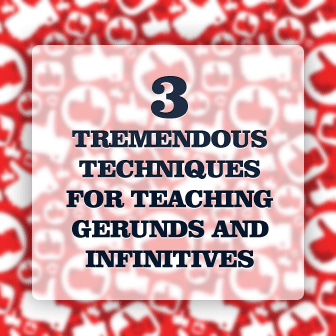
The topic of gerunds vs. infinitives is a notoriously confusing one among students of all levels.
To native speakers it comes naturally, and we don’t really ever think about why we use one instead of the other. For ESL students getting it right may take some time and patience and hopefully these 3 techniques for teaching gerunds and infinitives will bridge the gap.
Teaching Gerunds and Infinitives
-
1
I Like to Swim or Swimming Is Fun: Define the Differences
At the basic level you will need to start out just by distinguishing the difference and doing this while keeping your language pretty simple. Here’s an example that has been quite successful. The most confusing part in choosing either a gerund or an infinitive is that they have similar jobs and perform many of the same functions.
They both:
- Look like verbs, but are actually nouns.
- Can be the subject of a sentence: Jogging is good exercise. To jog is good exercise.
- Can be the object of a verb: I like reading books. I like to read books.
Only gerunds:
- Can be the object of a preposition, for example: We are talking about swimming in English class. We discussed quitting smoking for good.
So when do we know when to use one or the other? That can difficult to define. In general, the rule to follow is:
Gerunds are used to express actions that are real, concrete and completed.
Infinitives are used to express actions that are unreal, abstract or may be in the future.
You can provide some examples and then discuss which category they fall into. For example:- I forget locking the door.
- I forgot to lock the door.
- I stopped smoking.
- I stopped to smoke.
-
2
List of Verbs
Because gerunds and infinitives have this difference discussed above, one way to help them remember is to provide a list of verbs. The list of verbs followed by gerunds is more concrete while the verbs followed by infinitives are more abstract.
Here is a short list for each:Verbs Followed by Gerunds Verbs Followed by Infinitives Admit Deny Miss Agree Learn Wish Discuss Dislike Mind Ask Manage Happen Enjoy Suggest Practice Forget Prepare Demand Quit Understand Consider Need Want Deserve Verbs followed by either Begin Hate Like Love Plan Prefer Intend Remember Can’t stand With these lists obviously comes a lot of vocabulary explanation. Introduce possibly 5-10 words in each category and take the time to provide definitions, do comprehension checks, and then present examples with the difference. Here are some examples:
- I want to go, do, see, play—same for negative—I don’t want to (go, do, see, play)
- I enjoy skiing, swimming, reading not I enjoy to ski, to swim, to read.
This will take some time for student to absorb and may also take some extra studying on the teacher’s part as distinguishing between gerunds and infinitives does not come easily to any one of. You can practice the above simply by having them perform a fill in the blank exercise in rounds. You can also have them plan some type of event and have the students incorporate the specific verb usage into their discussion. For example, plan a birthday party for John. What will you need to remember to do? What will you need to prepare? What does he like/love/enjoy/hate/etc.?
-
3
Giving Opinions
Combining gerunds and infinitives practice with expressing opinions can be a good start. Because this grammar point is so involved and students need to learn it in chunks, devising ways they can practice parts of it realistically will help to solidify the usage. Give the students a list of topics that they can discuss using the words from the verb lists they are working on. Some of the topics could be current event-related or more general issues. For example: What do you think about:
- The presidential election
- The earthquake in Japan
- The World Cup
Another way to do this is to give them prompts to complete regarding tastes, and have them agree or disagree with another.
- I can’t stand…
- I hate…
- I prefer…
- I enjoy….
- I wish…
Teaching gerunds and infinitives is quite involved and students will have a lot of questions.
Remember to start out simply and build upon what they know. Combine hands-on discussion and activities with fill in the blanks, quizzes and competitions.
P.S. If you enjoyed this article, please help spread it by clicking one of those sharing buttons below. And if you are interested in more, you should follow our Facebook page where we share more about creative, non-boring ways to teach English.








